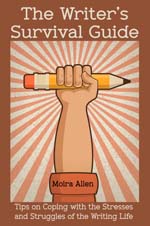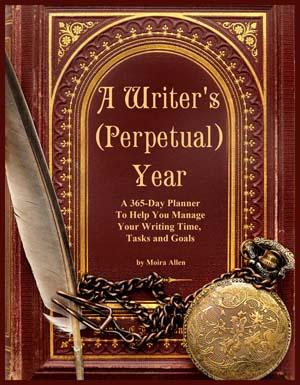 Your Guide to a Successful Writing Career
| ||||
|
by Moira Allen
Ironically, despite the push to present information, many corporations have cut back on the staff needed to present it effectively. Editorial departments are often the first to feel the effects of "corporate downsizing" -- and many corporations have found that it is far cheaper to hire freelancers on a part-time contract basis than to maintain a full-time, salaried editorial staff. That's where you come in. With your blue pencil and an eagle-eye for typos, you can keep the information flowing (and even help make it readable). But first, it's important to know how the corporate "editorial process" works. In most companies, a document (such as a report) goes through several stages before it is published. First, a draft is circulated for management or peer review, after which the author may make changes or revisions. In some cases, that's the most editing a manuscript receives; after incorporating management suggestions, the author may simply hand the piece to the nearest secretary to correct and print. In an ideal world, however, the manuscript will then pass through several editorial stages, including:
A "content editor" addresses issues of content and style. To ensure that a document accomplishes the purpose for which it is written, a content editor usually reviews the material with the following questions in mind:
In some cases, you may be expected to have some background in the subject area of the document, so that you can determine whether material is presented effectively or accurately. In other cases, such knowledge won't be required (though it's always helpful!). Content editors may work closely with authors -- and many authors take exception to the notion that their work might need revision. Others are more than happy to dump a mess of incomplete sentences and half-finished ideas in your lap and say "Here, fix it!" Consequently, diplomatic skills may be as important as editorial skills!
After the revisions suggested by the content editor have been made (or ignored), a document usually moves on to the copy-editing stage. A copy editor usually focuses upon:
Whenever editorial changes and revisions are made to a document, a host of new errors may be introduced. One of the tasks of a copy editor is often to check the "original" against the "revised" document, to make sure that nothing has been inadvertently changed, omitted, or added. Similarly, a copy editor may review charts, graphs, and references for accuracy and consistency. While it can be frustrating to copy edit a document that obviously needs a solid "content" editing, most companies don't encourage copy editors to make substantive changes or suggestions about content or style. There are exceptions, but check before offering editorial comments. A copy editor usually isn't expected to have a knowledge of the subject matter. What is needed instead is a firm grasp of grammar -- and the ability to explain (and defend) grammatical changes to the author. So brush off your grammar books, and be prepared to explain concepts such as "dependent clauses" and "sentence fragments."
Proofreading is usually the last editorial stage. Unfortunately, it is also often the only editing many documents receive. Proofreaders are generally expected to check only for errors in spelling, punctuation, and format. Sometimes you may be permitted to correct blatant grammatical errors -- but don't count on it! Proofreaders also check charts and graphs -- and since these are often re-keyboarded by someone other than the author, the proofreader may be asked to verify every number against the original. A proofreader may also be asked to check a revised manuscript against the original, marked-up copy. Sometimes a proofreader will also be asked to compare two documents word-for-word (whether revised or not). Usually this task is unnecessary, being a holdover from the days when a typesetter would re-keyboard an entire text rather than simply reprinting a file -- but some companies haven't caught up with their own technology! Proofreaders need no special subject knowledge, but an absolutely perfect command of spelling and punctuation, and a keen eye. You may also be asked to check spellings of technical terms. (If the terms are unfamiliar, try to obtain a relevant dictionary; fortunately, many scientific and technical dictionaries are now available online.) You will also be expected to be familiar with, and use, standard proofreading marks. The Corporate MentalityEditing for corporations is not the same as editing a book or magazine manuscript. In business, "quality" writing may not be nearly as important as conveying a particular idea, message, statistic, or product to a selected audience. Often, corporate editing means making tradeoffs in priorities, such as:
Keep in mind as well that financial officers have interesting ways of looking at hourly rates. For example, if you are a fast, efficient worker who charges $50 an hour for five hours, you may be considered "more expensive" than an editor who charges $40 an hour for ten hours. One alternative is to charge by the job instead of the hour, or by a more "tangible" measure, such as "per page." Facts don't speak for themselves. They need someone to speak for them -- and, quite often, someone to edit the words of that speaker. Once you convince companies that you can make them shine by making their prose shine, you'll be on your way to developing a loyal customer base -- and an excellent source of freelance income. Find Out More...
This article originally appeared on Writer on Line.
Moira Allen is the editor of Writing-World.com, and has written nearly 400 articles, serving as a columnist and regular contributor for such publications as The Writer, Entrepreneur, Writer's Digest, and Byline. An award-winning writer, Allen is the author of numerous books, including Starting Your Career as a Freelance Writer, The Writer's Guide to Queries, Pitches and Proposals, and Coping with Sorrow on the Loss of Your Pet. In addition to Writing-World.com, Allen hosts VictorianVoices.net, a growing archive of articles from Victorian periodicals, and The Pet Loss Support Page, a resource for grieving pet owners. She lives in Kentucky with her husband and the obligatory writer's cat. She can be contacted at editors "at" writing-world.com. |
| |||
| ||||




